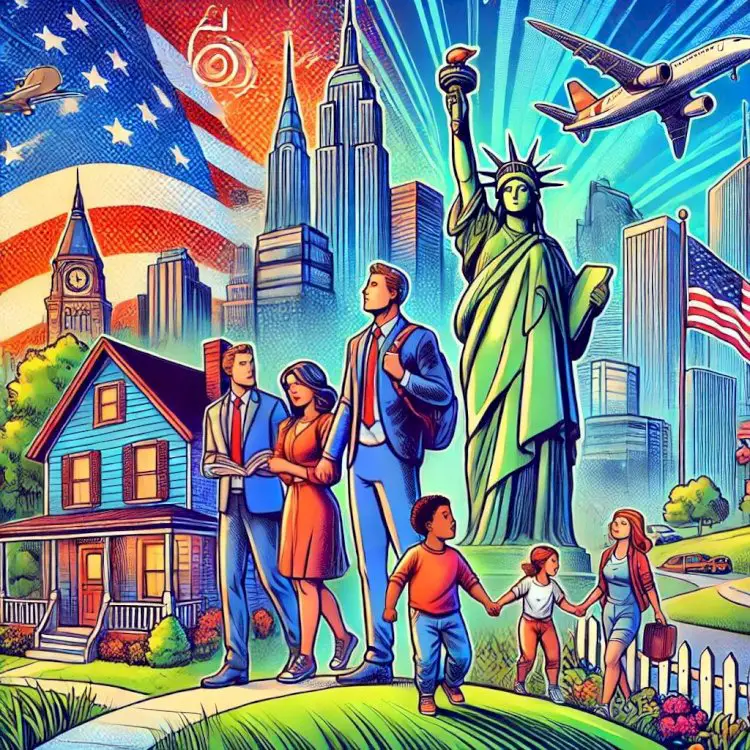The American Dream: An Enduring Ideal in the Face of Modern Challenges
The American Dream, a concept deeply embedded in the nation's identity, has captivated generations with its promise of opportunity, freedom, and upward mobility. This enduring ideal has served as a beacon of hope for many, both within the United States and abroad. However, the evolving nature of the American Dream and the challenges faced in its pursuit have sparked debate about its attainability in contemporary society. This blog delves into the historical context of the American Dream, explores its current state, and examines the criticisms and challenges it faces in the 21st century.

1. Defining the American Dream
At its core, the American Dream embodies the belief that anyone, regardless of their background or social standing, can achieve success and prosperity through hard work and determination. James Truslow Adams, who coined the term in his 1931 book "Epic of America," described it as "that dream of a land in which life should be better and richer and fuller for everyone, with opportunity for each according to ability or achievement." [1] This ideal is rooted in the principles of democracy, liberty, and equality, offering the prospect of upward social mobility and a better life for all [2].
Over time, the American Dream has been interpreted in various ways. While some emphasize material wealth and homeownership as key indicators of success, others prioritize individual fulfillment, freedom of choice, and making valuable contributions to society [1]. Regardless of the specific interpretation, the underlying principle remains the same: the belief in a society where individuals have the opportunity to improve their lives and achieve their full potential.
2. Historical Context and Evolution
The roots of the American Dream can be traced back to the colonial era, fueled by the allure of frontier life and the pursuit of new opportunities [4]. This was further influenced by a "colonial mystique regarding frontier life and the belief that lands further off are better than those upon which they are already settled." [2] The Declaration of Independence, with its emphasis on "Life, Liberty and the pursuit of Happiness," further solidified the foundation for this ideal [5]. Throughout the 19th and 20th centuries, the American Dream evolved alongside the nation's social and economic landscape.
The Progressive Era witnessed a shift in focus towards social and economic equality, with reformers advocating for policies that would protect workers and communities from the excesses of industrial capitalism [6]. The Great Depression, during which Adams popularized the term "American Dream," brought renewed attention to the importance of economic security and upward mobility [2].
The post-World War II era saw the American Dream become increasingly associated with material prosperity, fueled by a booming economy and the rise of consumerism [7]. Homeownership, a stable job, and access to education were seen as essential components of achieving the dream [1]. However, this period also witnessed growing social and economic inequalities, raising questions about the accessibility of the American Dream for all.
3. The Current State of the American Dream
In recent decades, the attainability of the American Dream has been a subject of considerable debate. While a majority of Americans still believe in the ideal, there is growing concern about the challenges faced in its pursuit [8]. A 2024 study by the Archbridge Institute found that 7 in 10 Americans believe they have achieved or are on their way to achieving the American Dream, but an increasing number (32%) feel it is out of reach [8]. This growing pessimism is reflected in findings that show a majority of Americans (60%) believe that the American Dream "was once true, but isn't anymore." [9]
Several factors contribute to this growing pessimism. Rising income inequality, stagnant wages, and increasing costs of living, particularly for housing and healthcare, have made it more difficult for many to achieve economic security and upward mobility [1]. A 2024 Pew Research Center study found that Americans are divided on whether the American Dream is still possible, with older adults and those with higher incomes expressing greater optimism [10].
Furthermore, there are significant generational differences in perceptions of the American Dream. Younger adults are less likely than older generations to believe it is still possible to achieve [11]. This may be attributed to factors such as student loan debt, a competitive job market, and concerns about climate change and economic instability. This trend of increasing pessimism, particularly among younger generations and those with lower incomes, raises concerns about the future of the American Dream and its potential impact on social cohesion and economic mobility [9].
4. Perceptions Across Demographics
The perception of the American Dream varies across different demographic groups in the US. While a majority of Americans across racial and ethnic groups believe the dream is attainable, there are notable differences in how they define it and the challenges they face in achieving it [3]. These differences are summarized in the table below:
|
Demographic Group |
Achieved |
On the Way |
Out of Reach |
|---|---|---|---|
|
Age 50+ |
68% |
- |
- |
|
Age < 50 |
42% |
- |
- |
|
Upper Income |
64% |
- |
- |
|
Middle Income |
56% |
- |
- |
|
Lower Income |
39% |
- |
- |
|
White |
39% |
42% |
15% |
|
Black |
17% |
62% |
19% |
|
Hispanic |
32% |
51% |
17% |
|
Republican |
38% |
34% |
- |
|
Democrat |
28% |
38% |
- |
It is important to note that despite the disparities observed in achieving the American Dream, there are no significant racial or ethnic differences in the shares who say the American Dream is out of reach for their families [13]. This finding challenges the assumption that minority groups are inherently more pessimistic about the American Dream and suggests that the belief in its unattainability is a growing concern across racial and ethnic lines.
Political affiliation also plays a role in how Americans perceive the American Dream. Republicans are more likely than Democrats to say they have achieved the dream, while Democrats are more likely to say they are on their way to achieving it [10]. This may be influenced by differing views on the role of government and social safety nets in facilitating upward mobility.
5. Criticisms and Challenges
The American Dream has faced criticism for its emphasis on material success and its potential to perpetuate inequality. Some argue that the pursuit of wealth and status can come at the expense of community, social responsibility, and environmental sustainability [6].
Inequality and Systemic Barriers
The American Dream has been criticized for overlooking the systemic barriers faced by marginalized communities, such as discrimination, lack of access to quality education and healthcare, and unequal opportunities [14]. These challenges can make it significantly more difficult for individuals from disadvantaged backgrounds to achieve upward mobility, regardless of their hard work and determination.
The Changing Nature of Work
Another challenge to the American Dream is the changing nature of work and the economy. Globalization, automation, and the rise of the gig economy have created new uncertainties and challenges for workers, making it more difficult to achieve job security and build long-term financial stability [15]. For aspiring entrepreneurs, challenges such as inertia, isolation, and lack of structure can hinder their ability to establish and grow successful businesses [15]. These challenges highlight the difficulties faced by individuals in pursuing the American Dream through entrepreneurship, which is often seen as a key pathway to achieving it.
Entitlement and Instant Gratification
Furthermore, some argue that a sense of entitlement and a desire for instant gratification among some Americans contribute to the challenges facing the American Dream [16]. This perspective suggests that a shift in values and attitudes may be necessary to revitalize the pursuit of the American Dream.
6. The American Dream: A Global Perspective
The American Dream has resonated beyond the borders of the United States, inspiring individuals in many countries to strive for a better life. However, the concept has also been compared and contrasted with similar ideals in other nations [17].
The "European Dream," for example, often emphasizes community, quality of life, and social welfare over individual achievement and material wealth [18]. This is reflected in the prioritization of "work to live" rather than "live to work" and the importance placed on community relationships over individual autonomy [19].
In China, the "China Dream" focuses on national rejuvenation and collective prosperity, with a greater emphasis on unity and stability [20]. This contrasts with the American Dream's focus on individual aspiration and endeavor.
These comparisons highlight the diverse cultural and societal values that shape perceptions of success and opportunity around the world. While the American Dream continues to hold appeal for many, its relevance and attainability in the 21st century are increasingly being evaluated in light of global trends and challenges. It is worth noting that despite these differences, the hope that children will grow up to have higher standards of living than their parents is a common aspiration across many nations, including the United States [21].
7. Conclusion: Redefining the Dream
The American Dream remains a powerful and enduring ideal, but it is not without its challenges. In the face of rising inequality, economic uncertainty, and social divisions, it is essential to critically examine the concept and redefine it for the 21st century [6].
This may involve shifting the focus from solely material success to a broader definition that encompasses well-being, social mobility, and equal opportunities for all. It also requires addressing the systemic barriers that prevent many Americans from achieving their full potential, regardless of their background or circumstances.
Redefining the American Dream requires acknowledging the diverse experiences and perspectives of different demographic groups. While older generations may view the dream as largely attainable, younger generations face unique challenges that require innovative solutions. Addressing the concerns of those who feel the dream is out of reach, particularly those from lower-income backgrounds and marginalized communities, is crucial to ensuring a more inclusive and equitable society.
By acknowledging the complexities and challenges surrounding the American Dream, and by engaging in open and honest dialogue about its future, we can work towards creating a society that truly lives up to its promise of opportunity and prosperity for all.
References
- What Is the American Dream? Examples and How to Measure It, accessed January 16, 2025, https://www.investopedia.com/terms/a/american-dream.asp
- American Dream - Wikipedia, accessed January 16, 2025, https://en.wikipedia.org/wiki/American_Dream
- What Americans believe about the American Dream - Badger Institute, accessed January 16, 2025, https://www.badgerinstitute.org/what-americans-believe-about-the-american-dream/
- en.wikipedia.org, accessed January 16, 2025, https://en.wikipedia.org/wiki/American_Dream#:~:text=Historically%2C%20the%20Dream%20originated%20in,which%20they%20are%20already%20settled%22.
- American Dream | Definition, Examples, & In Literature | Britannica, accessed January 16, 2025, https://www.britannica.com/topic/American-Dream
- The Original Meanings of the “American Dream” and “America First” Were Starkly Different From How We Use Them Today - Smithsonian Magazine, accessed January 16, 2025, https://www.smithsonianmag.com/history/behold-america-american-dream-slogan-book-sarah-churchwell-180970311/
- The Evolution of the American Dream - TheCollector, accessed January 16, 2025, https://www.thecollector.com/american-dream-evolution/
- American Dream 2024 Snapshot: The Health and State of the American Dream, accessed January 16, 2025, https://www.archbridgeinstitute.org/american-dream-snapshot/
- The State of “the American Dream” and How Progressive Economic Policies Can Rebuild It, accessed January 16, 2025, https://navigatorresearch.org/the-state-of-the-american-dream-and-how-progressive-economic-policies-can-rebuild-it/
- Americans are split over the state of the American dream - Pew Research Center, accessed January 16, 2025, https://www.pewresearch.org/short-reads/2024/07/02/americans-are-split-over-the-state-of-the-american-dream/
- What Does the American Dream Mean to Different Generations? - Investopedia, accessed January 16, 2025, https://www.investopedia.com/ask/answers/062215/what-does-american-dream-mean-different-generations.asp
- Americans are far more likely to believe in the American Dream now than they were a year ago | YouGov, accessed January 16, 2025, https://today.yougov.com/politics/articles/45934-more-americans-believe-american-dream-now
- Most think the 'American dream' is within reach for them - Pew Research Center, accessed January 16, 2025, https://www.pewresearch.org/short-reads/2017/10/31/most-think-the-american-dream-is-within-reach-for-them/
- Opinion: The concept of American dream is flawed, because it is not for Americans, accessed January 16, 2025, https://highschool.latimes.com/arcadia-high-school/opinion-the-concept-of-american-dream-is-flawed-because-it-is-not-for-americans/
- Challenges with the American Dream - CKH Group, accessed January 16, 2025, https://www.ckhgroup.com/pursuing-the-american-dream/
- The American Dream Isn't Dead, It's Just Misunderstood, accessed January 16, 2025, https://americancompass.org/american-dream-isnt-dead/
- Belief In The "American Dream" Is Higher Abroad Than At Home, According To Report From Global Network Of 60,000, accessed January 16, 2025, https://www.prnewswire.com/news-releases/belief-in-the-american-dream-is-higher-abroad-than-at-home-according-to-report-from-global-network-of-60-000--301422785.html
- A United Europe in the 21st Century: Eclipsing the American Dream? by Rick Steves, accessed January 16, 2025, https://www.ricksteves.com/tv-programmers/pledge/a-united-europe-in-the-21st-century-eclipsing-the-american-dream
- The not-American dream: Do other countries have national catchphrases?, accessed January 16, 2025, https://slate.com/news-and-politics/2011/06/the-not-american-dream-do-other-countries-have-national-catchphrases.html
- The China Dream Vs. The American Dream - The Diplomat, accessed January 16, 2025, https://thediplomat.com/2014/09/the-china-dream-vs-the-american-dream/
- The American Dream is less of a reality today in the United States, compared to other peer nations, accessed January 16, 2025, https://equitablegrowth.org/the-american-dream-is-less-of-a-reality-today-in-the-united-states-compared-to-other-peer-nations/
What's Your Reaction?

















